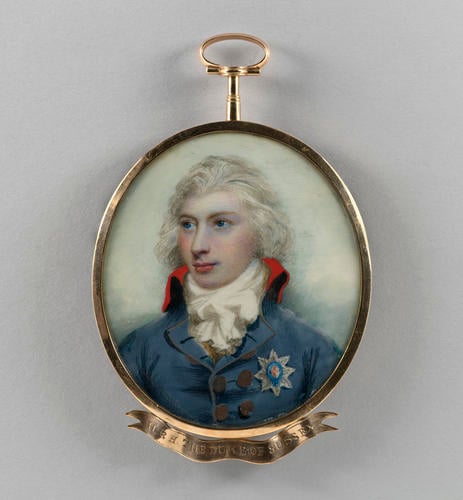-
1 of 253523 objects
Augustus, Duke of Sussex (1773-1843) c.1790-91
Watercolour on ivory | 6.4 x 5.7 cm (sight) | RCIN 420991

Attributed to Anne Mee (1770-1851)
Augustus, Duke of Sussex (1773-1843) c.1790-91
-
Prince Augustus (1773-1843) is wearing Hanoverian uniform with the star of the Order of the Garter. Augustus was the sixth son and ninth child of George III and Queen Charlotte. From 1786, when he entered the University of Göttingen, Germany, until 1804, he mostly resided abroad. As a young man, he suffered severely from asthma and his frail health prevented him from joining the army or navy. When living in Rome, he met and secretly married Lady Augusta Murray, a Catholic, in 1793. This contravened the provisions of the Royal Marriages Act of 1772, and the marriage was declared void by the king in August 1794. They had two children. In 1801, Prince Augustus was created Duke of Sussex, Earl of Inverness and Baron Arklow. He became estranged from his father and the court because of his liberal political views. He supported the abolition of the slave trade, Catholic emancipation, the removal of civil restrictions on Jews and dissenters, the abolition of the Corn Laws and parliamentary reform.
Augustus was elected president of the Society of Arts in 1816, and from 1830-8 was president of the Royal Society. He built up a large library of over 50,000 volumes, including about 1,000 editions of the Bible, and many ancient manuscripts. In 1831, he married Lady Cecilia (1793–1873), daughter of the second Earl of Arran. When he died, The Times commented that ‘No death in the royal family short of the actual demise of a monarch could have occasioned a stronger feeling of deprivation’. In his will, he asked that his remains should not be interred with the royal family at Windsor, and he was buried in the public cemetery at Kensal Green.
It is thought that the artist is Anne Mee (1780/5-1851), the daughter of the artist John Foldsone. She was educated in London and was a protégée and pupil of the portrait painter George Romney. Lady Courtown introduced her to Queen Charlotte, and Charlotte Papendiek, journalist and assistant keeper of the wardrobe to Queen Charlotte, described Anne Mee drawing the queen and princesses at Windsor in 1790. Mee visited frequently after that date. Her portraits are often characterised by large eyes, and by 1804 she was able to ask as much as 40 guineas for a miniature.
Tresses of dark brown hair are woven in the back of the case.
Provenance
Acquired by Queen Mary from the Duchess of Cambridge
-
Creator(s)
Acquirer(s)
-
Medium and techniques
Watercolour on ivory
Measurements
6.4 x 5.7 cm (sight)
9.5 x 6.1 cm (frame (miniature), with ring open/up)
8.7 cm (frame (miniature), with ring closed/down)
Category
Object type(s)